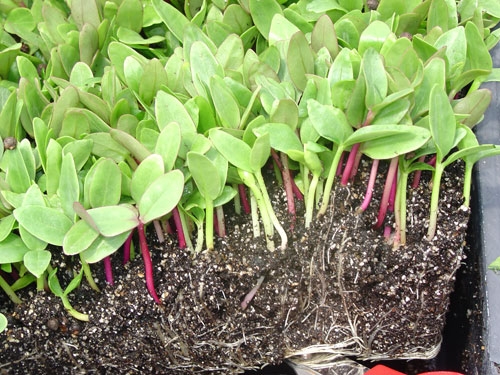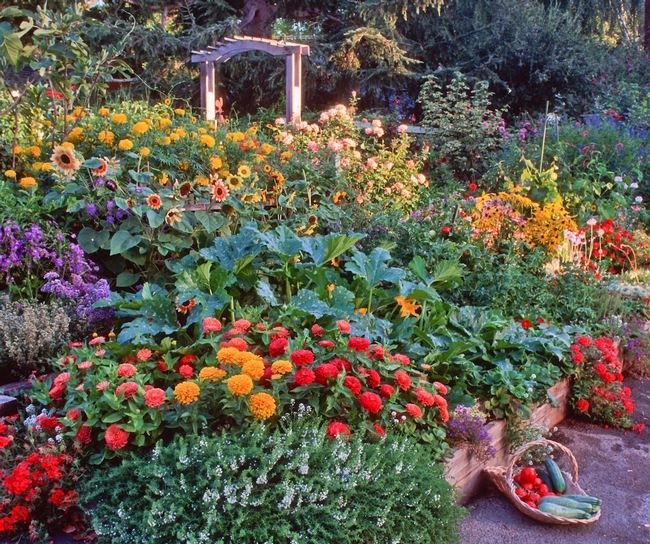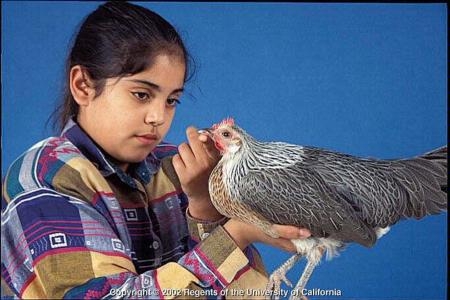Posts Tagged: Pam Geisel
Workshop helps you design your landscape and eat it, too
Edible landscapes are growing like zucchini in the sun as more people recognize the health and economic benefits of designing their yards with pretty plants that taste good, too.
“Sales of fruits and vegetables have remained strong, even during this recession when sales of other plants have lagged,” said Ron Hoffman, owner of Morris Nursery in Riverbank, Calif., echoing the sentiments of many in the state’s nursery industry. “People enjoy growing their own produce and they want plants that do double duty.”
And when they choose brightly colored edibles — like, say, Neon Lights swiss chard or Bronze lettuce — they can have their landscape and eat it, too. But designing and maintaining an edible landscape is easier said than done. How do you know what plants to choose? What if one plant needs different soil and more water than its neighbor? How do you keep the cat from pooping on your produce?
The folks at the UC Cooperative Extension Master Gardener Program, with assistance from California Center for Urban Horticulture at UC Davis, are answering those questions and many more at 6 two-day, “train the trainer” workshops throughout the state. Funded by a two-year grant from UC Agriculture and Natural Resources, the program teaches the art and science of edible landscaping to master gardeners who, in turn, will help train the rest of us.
“Before you install an edible landscape, you need to assess the site and the user,” said Missy Gable, program manager for the California Center for Urban Horticulture. “How much time do you have to devote to gardening? What are your harvest needs? We brought together experts from diverse fields such as landscape architecture, horticulture, food safety and water policy to provide an overview of what’s possible with edible landscaping.”
The workshops are inexpensive — $35 for master gardeners and $65 for industry professionals. In exchange for their reduced rate, master gardeners sign an agreement to teach two classes within three months of their training — one for fellow master gardeners and one for the public. Cheryl Buckwalter, a professional landscaper and executive director of EcoLandscape California, attended an earlier workshop and called the experience “invaluable.”
“Today's landscapes need to work harder than ever,” Buckwalter said. “They need to be water and resource efficient, functional and aesthetically pleasing. The Edible Landscaping Workshop not only showed me how to design the multi-functional landscape of today by incorporating edibles, I also feel qualified to educate my clients, the public and other professionals.”
Will the workshops change the way people garden?
“As part of the project, we’ll be looking at that very thing,” said Pam Geisel, director of the UC Statewide Master Gardener Program and the project’s principal investigator. “We will evaluate the impact of train-the-trainer methodologies to determine whether participants adopt more productive, sustainable landscapes as a result of being trained or from training others.”
The benefits of edible landscaping are bountiful. Parents, for example, love exposing their children to both the joy of gardening and the value of healthy food. Farmers appreciate that more people realize produce doesn’t grow on grocery store shelves. But without a few pointers, it’s easy to err with edibles. Sometimes, for example, our eyes are too big for our stomachs.
“Like me,” Gable said. “I’m a plant nerd. This summer I bought four varieties of zucchini because they were so cool. Believe me, no one needs four varieties of zucchini.”
No two yards or gardeners are the same and the course helps people customize their plan to meet their needs. Do you work 12-hour days? Maybe it’s better for you to help out at a community garden than plant too many edibles in your own back yard. Is your garden in full shade?
“Grow blueberries,” Gable said.
There is still room in four Edible Landscaping Workshops this fall: Oct 11-12 in Santa Clara; Oct. 24-25 in El Cajon; October 26-27 in Los Angeles; Nov. 2-3 in Fresno; and Nov. 30-Dec. 1 in San Luis Obispo. You can register and find more details at http://cchu.ucdavis.edu/events/edible/edible
Media contacts:
- Pam Geisel, Director of the Statewide Master Gardener Program, (530) 865-1154, pgeisel@ucanr.edu
- Missy Gable, California Center for Urban Horticulture at UC Davis, (530) 752-6642, mjborel@ucdavis.edu
- Diane Nelson, UC Davis College of Agricultural and Environmental Sciences, (530) 752-1969, denelson@ucdavis.edu
Urban chickens are fun and a current fad
Cities throughout the United States and Canada are reforming land-use and health policies to allow and encourage urban agriculture - including raising chickens, wrote Josie Garthwaite in the New York Times.
Among her sources for the story was the director of UC Cooperative Extension's Statewide Master Gardener Program Pamela Geisel, who keeps 10 hens at her own rural home west of Chico.
She said enthusiasm for homegrown hens in urban areas may be close to peaking.
“It’s sort of a fad,” she said. Still, “it’s easy to buy chicks, and they’re cheap."
Most of the potential problems tend to arise from having too many chickens in too little space, she said, so regulations for the size and housing of backyard flocks can “help chicken keepers be better chicken keepers.”
She cautioned that keeping chickens involves a significant effort.
“The poop just doesn’t go away — it’s a constant daily cleanup,” she said. “They get sick, they get parasites. For many people it’s just not worth the effort.”
California's growing marijuana business impacting agriculture
Harry Cline, Western Farm Press
California has the dubious distinction of being America’s biggest marijuana supplier. Approximately 75 percent of the marijuana sold in the U.S. is grown in California — not Mexico.
Michelle Le Strange, UCCE farm advisor in Tulare County, said she has been warned by county officials and law enforcement officers that she should be alert in driving a county vehicle in rural areas because marijuana plantation tenders might think she is a law enforcement officer, and she could be in danger.
Any government officials driving vehicles with government plates should be concerned because these marijuana plantations are operated by Mexican drug cartels, the same lawless gangs who are responsible for thousands of murders each year in Mexico. These cartels actually scour the U.S. Forest Service lands in search of ideal growing sites, often adjacent to running streams. The cartels stock these plantations with people, drip irrigation tubing and chemicals to farm the illegal weed.
Microgreens are houseplants you can eat
Another way to engage the family in sustainable living and healthy eating is by starting a table-top farm at home. Growing sprouts has been popular for decades. Today, microgreens are the new hot topic.
Microgreens are larger than sprouts, but smaller than baby salad greens. They are found in trendy restaurants and gourmet grocery stores, but can easily be grown anywhere with sufficient light, says Marin County UC Master Gardener Dot Zanotti Ingels. Harvested at about two inches tall, they add texture and flavor to salads and sandwiches, can be mixed into dips, used as a garnish and sprinkled on top of pizza.
“Children like microgreens because they are fast growing with quick rewards,” she said. “Nutritionally, microgreens are loaded with vitamins, minerals, enzymes and phytonutrients.”
To grow microgreens, all you need are containers, soil, seeds and water.
“I like to use attractive containers or small pots to keep my growing area fun to look at, but containers could be recycled plastic food trays or a wide, shallow flower pot,” Ingels said.
She suggests the following steps:
- Fill the container with moistened fresh potting mix or seed starting mix to one-inch of the top. Another option is using soilless germinating media, such as a growing mat, peat, vermiculite, perlite or coconut fiber.
- Sprinkle seeds evenly to cover one-third to one-half of the soil or growing media surface (buying bulk seeds online will save money).
- Top the seeds with a thin layer of soil and tamp down lightly.
- Water with a spray bottle, keeping the soil as moist as a wrung-out sponge.
- Start with or without a clear cover; once seeds have germinated, keep the container open.
- Harvest when the first true leaves appear by snipping with sharp kitchen shears. Seedling to harvest varies from 7 to 21 days.
Chia, cress, mustard greens, radish and arugula are just a few of the varieties used to grow microgreens. Pam Geisel, the academic coordinator of the UC Master Gardener program, suggests trying borage, basil, cilantro and other leafy herbs. A good plant to try first is broccoli, since it tends to be reliable in germination and a strong sprout in the first crucial days.
To ensure success and food safety, Geisel recommends microgreen growers compost the old soil or growing medium and start over new with each planting.
“When reusing soils, there can be a problem with damping off and other organisms, such as salmonella,” Geisel said. Damping off is the term used for fungus-caused ailments that kill seeds or seedlings. “Microgreens don’t have a lot of roots so the soil or mats have to be watered often but not kept soggy wet. I would not use the greens if there is any sign of mold or decay.”

Microgreens are larger than sprouts, and smaller than baby salad greens.
Master Gardener news feature 'goes viral'
Alameda County UC Cooperative Extension Master Gardener Birgitt Evans knows a lot about dirt, according to an article in The Bay Citizen. And now, a lot of people know about Birgitt Evans.
Evans sat down for a lengthy interview with reporter Heather Lynn Wood, who published the Q&A session on winter gardening, getting a garden started, composting and tools, and recounted the Master Gardener training process. The result of each volunteer's 17-week certification course, the story said, is an expert gardener armed with a wealth of research-based information and the ability to mentor others.
"Sometimes the work of Master Gardeners goes viral...and we love it!" wrote statewide Master Gardener academic coordinator Pam Geisel in her blog. "Instead of staying local, (the story) made a big splash all over the Bay Area."
Geisel blogged about her delight that the article shared a message about growing vegetables, and also highlighted the statewide Master Gardener program and it's connection to UC. Wood wrote that UC Agriculture and Natural Resources "has representatives like Evans in each California county." ("Well, that is almost true," wrote Geisel.)
The Bay Citizen story is the first in a series of conversations about gardening in Alameda.

Evans says winter is a good time to compost. Above, an MG compost demonstration.
Master Gardeners can't help with this weed
The UC Cooperative Extension Master Gardener program won't give advice about growing marijuana, even if it is grown legally, according to a Los Angeles Times blog post by Jeff Spurrier.
Spurrier, who is himself a volunteer Master Gardener, reported that UC Master Gardener academic coordinator Pam Geisel recently passed along word from the UC Regents general counsel that Master Gardeners cannot offer assistance on marijuana growing, propagation or problem diagnosis.
To be sure, the new edict doesn't require dramatic changes in Master Gardener programs. Inquiries about marijuana production are rare.
The UC Cooperative Extension horticulture advisor in Los Angeles County, Yvonne Savio, told the blogger she knew of only one call to the Master Gardener office about marijuana.
"The caller asked about growing a ‘grass,’ but when our MG suggested growing a drought-tolerant variety, the caller specified, ‘No, I mean marijuana’ to which our MG replied, 'No, I’m sorry, I can’t respond to that,'" Savio was quoted in the post.


